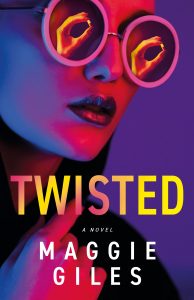Reading without Seeing
Reading without Seeing
Maggie Giles
 I have aphantasia.
I have aphantasia.
When I tell people this, it’s usually followed by the question “what’s that?” Aphantasia is often described as a visual condition, when one lacks the mind’s eye and are unable to picture images in their head, but in reality, aphantasia is a multisensory condition and it’s on a spectrum.
Sometimes described as a “sixth sense”, Aristotle first coined this as “phantasia” (often translated to mean imagination); the “a” in a-phantasia denotes its absence. An estimated 3-5% of the population experience aphantasia, and another 10-15% are believed to experience the opposite, hyperphantasia (extremely vivid imagination).
As mentioned above, aphantasia is more than just visual. It can involve all your senses. People with aphantasia on average have reduced ability with other mental senses and approximately 26% of aphantasics have “a total absence of multi-sensory imagery.” This lack of all mental senses is sometimes called total aphantasia.
Today I will focus on my visual aphantasia.
While I could delve into the history and give you a background on the studies in aphantasia, the timeline would be a short one, as in modern days. The term wasn’t coined until 2009. There have since been studies done on aphantasia and the creation of the Aphantasia Network to help bring awareness to it.
Once I explain what it is, often I’m asked how I knew that I had it. Or how I found out. Since it is a fairly new terms, many people are still unaware that they may have this condition. Do you picture the scenery when you read? See your main character? Are able to pull up an image in your mind and describe it? Then you don’t suffer from a visual aphantasia. I, however, see nothing. It’s all black and dark up there when I try to picture something described to me.
For most, they don’t realize that they have it until it’s brought up. I didn’t realize that I saw (or didn’t see!) anything differently from others. Sure, I never really understood when someone said a movie character didn’t line up to the image they’d imagined, or that they’d thought a certain scene in a book would play out aesthetically different, but I never thought twice about it. I figured they just had their own idea of what they wanted to see. Later I realized that of course they did, but what I hadn’t understood was that they actually saw these ideas in their heads while they read along with the story.
I’ve been asked if this discovery has ever affected my love of reading. I’ve been a huge reader and storyteller since I was a child. I never worried too much about the pictures I didn’t see in my head (of course not realizing this was abnormal!) and focused instead of the dialogue and plot that drew me in. Not mentally seeing has never affected the emotions I feel or the intensity of a story. It has never taken away from the romance or the adventure. I’ve always had my own idea of what was happening, I just didn’t see it play out in my head.
Although I’ve come to terms with this lack of visual imagination, I do sometimes wonder how my reading and writing experience could be different if I didn’t have a blind mind’s eye. Would I enjoy the process even more if the picturesque settings rolled through my head like a movie or would it take away from the things I love, witty dialogue and an attention grabbing plot? Obviously, this is something I will never really know.
As an author, I’ve also been asked how this affects my writing process. I never realized this before, but when I first started writing I rarely included any description. I didn’t care how the characters looked, how they dressed or what the room they were sitting in looked like. This was a blindness that I didn’t realize I had so how would I know to tie it into my work? It wasn’t until I started getting readers when they’d start asking me how things looked. Often times they wanted a series of descriptions to let them know what they as a reader were looking at. Not an unreasonable ask by any means, but something I truly struggled to grasp.
Since the discovery of my aphantasia, I’ve worked harder to notice descriptions in prose and try to read each part more carefully. Although it still doesn’t paint a picture in my mind, I can still draw on the items, like knowing my character has dark hair, or prefers to wear dresses, that the house she lives in is a small cottage, or a sprawling mansion. I can’t see it, but I can still remember it and use it as information as I read through the story.
This has also helped me with my own writing. Noticing how other authors tie in their descriptions and vivid detail has allowed me to take a lot of my “bare bones” drafts and weave in the color and scenery the story needs. It has helped me detach a bit from my condition and figure out how ensure that my readers are seeing everything I want them to, even if I am ultimately unable to see it myself.
I make use of a lot of visual aids, such as Pinterest boards, to really help me describe what my character is looking at. Since I struggle to pull up the picture in my head, using a photograph or drawing has proven to add a lot more depth and detail to my descriptions.
Do I wish I had a visual imagination? Absolutely, I totally envy the idea that someone can picture exactly what is being described to them in their head. But I also remind myself that while I may have aphantasia, I have not allowed this to ruin my love of reading. I still flock to the next book. I love to see on screen adaptations. And I will never tire of a good story.
If you want to learn more about aphantasia, I recommend visiting the Aphantasia Network at https://aphantasia.com/.
—
Maggie Giles is a Canadian author who is always looking for a new creative outlet. She dove into writing a novel head first. She has been a member of the Women’s Fiction Writers Association since 2014 where she volunteers as their Social Media Director. The Things We Lost, a suspenseful women’s fiction, is her first novel. Her second, Twisted, will be releasing with Rising Action September 19, 2023. Learn more about Maggie and her book on her website: maggiegiles.com
TWISTED
 Detective Ryan Boone thought the simple jewelry heist was an open and shut case. That is until he discovers an unknown drug, and this minor crime he was investigating may be tied to a string of seemingly unconnected murders.
Detective Ryan Boone thought the simple jewelry heist was an open and shut case. That is until he discovers an unknown drug, and this minor crime he was investigating may be tied to a string of seemingly unconnected murders.
Meanwhile, Mel Parker, unscrupulous leader of a less-than-legal high-end escort service, stumbles across the same pills. On top of protecting her “investment,” she has her own reasons for attempting to unravel the mystery behind the medication.
Ryan knows someone has the answers he seeks, and Mel can’t come forward. To complicate things further, five other women are implicated in the murders despite most having never met.
As the trail turns up as many mysteries as resolutions, Ryan and Mel must discover the twisted connection before someone else ends up dead.
For fans of The Wife Between Us by Greer Hendricks and Sarah Pekkanen, and When You Find Me by P. J. Vernon, Twisted will have you questioning the motive behind the murders and how exactly one can be found guilty when the evidence doesn’t add up.
PREORDER HERE
Category: On Writing































Comments (1)
Trackback URL | Comments RSS Feed
Sites That Link to this Post